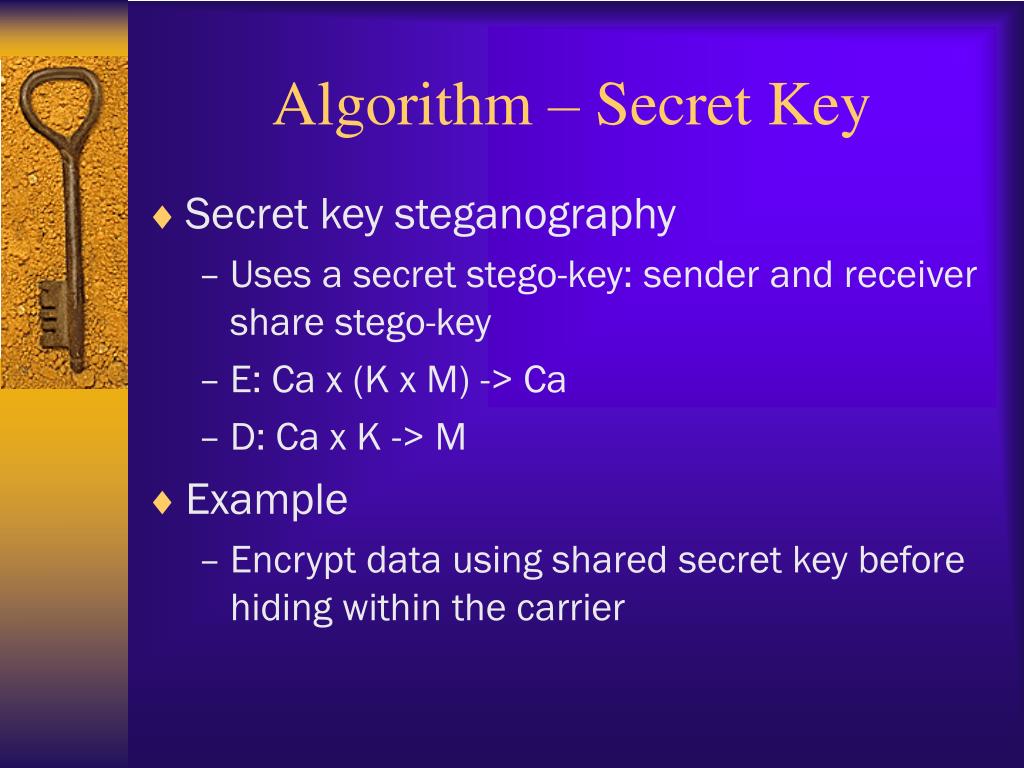In the realm of information security, steganography emerges as a fascinating discipline, intricately weaving together the concepts of confidentiality and communication. This clandestine art can be bifurcated into two fundamental paradigms: pure secret key stegosystems and public key stegosystems. Each approach offers unique mechanisms for covert data transmission while illuminating different facets of cryptographic intrigue.
Pure secret key stegosystems, often referred to as symmetric key systems, operate under the foundational principle of a shared secret. In this configuration, both the sender and the recipient utilize the same key for both encoding and decoding the message. This reciprocity establishes a bond of trust between the parties involved, yet it also presents a critical vulnerability—if the key is compromised, the entire communication can be jeopardized. The essence of this model lies in its simplicity. By employing straightforward algorithms, it allows for rapid processing and efficient data concealment.
Typically, the implementation of pure secret key stegosystems relies on various digital carriers, such as images, audio, or even video files. This melding of data uses techniques like least significant bit (LSB) insertion, where the message is nestled within the less significant bits of pixel values. This method, although seemingly innocuous, evokes profound curiosity: the mere act of concealing information in plain sight challenges the observer’s inclination to scrutinize the mundane.
However, the secret key approach is not without its inherent limitations. Key management becomes a paramount concern. As the number of users increases, so does the complexity of securely distributing and storing these keys. The burden of trust necessitates a reliable mechanism for key exchange, often leading to cumbersome procedures. Consequently, these obstacles inspire a fascination with alternative methods, paving the way for public key stegosystems.
Public key stegosystems, in stark contrast, leverage the principles of asymmetric cryptography. This paradigm harnesses a pair of keys: a public key, which can be disseminated freely, and a private key, which remains confidential to the owner. This duality invites a myriad of applications, as it allows anyone to encrypt a message using the public key, yet only the intended recipient, possessing the corresponding private key, can decrypt it. Such a framework significantly eases the challenges associated with key management, rendering it less susceptible to single points of failure.
The encapsulation of data in public key stegosystems is often more sophisticated, enabling the implementation of advanced algorithms that increase the encryption’s robustness. Techniques such as RSA (Rivest–Shamir–Adleman) and ECC (Elliptic Curve Cryptography) not only facilitate the encryption process but also imbue the system with an additional layer of complexity. This complexity tantalizes cryptanalysts, evoking a relentless pursuit to unravel the intricacies of cryptographic algorithms and their potential vulnerabilities.
Yet, this fascinating shift raises an essential question: Does the elegance of public key systems mean the demise of pure secret key approaches? The answer is nuanced. While public key systems exhibit distinct advantages, pure secret key stegosystems maintain a robust presence, particularly in environments demanding efficiency over intricate complexities. Their rapid performance and minimal processing overhead make them indispensable for specific applications, despite the inherent risks associated with key management.
Moreover, the intersection between the two steganographic systems is not merely theoretical. In reality, hybrid models are emerging, fusing the benefits of both paradigms while mitigating their inherent weaknesses. By using a pure secret key for the swift encryption of a small message and subsequently employing a public key to secure the transference of the secret key itself, these hybrids encapsulate the best of both worlds. Such innovations fuel a deeper intrigue into the steganographic landscape, prompting researchers to explore uncharted territories.
Another layer of complexity arises from the notion of embedding secret data within dynamic environments. As technology continuously evolves, so too does the capacity to conceal information within seemingly innocuous digital media. Consider the rise of social media platforms, where images and videos regularly serve as vehicles for both communication and professional storytelling. In such a milieu, the act of embedding information may not only serve a clandestine purpose but also inspire a deeper narrative. By inserting a hidden message within a viral image or a popular clip, individuals can engage in a form of digital artistry, challenging the observer to decipher hidden meanings behind the façade of entertaining content.
The implications of pure secret key and public key stegosystems are profound, extending beyond mere technicality. Both systems encapsulate a philosophical inquiry into trust, security, and the very nature of communication. The dance between encryption and revelation invites contemplation on the paradox of transparency in an increasingly surveillant digital age. As clandestine practices become more ubiquitous, the fascination with these steganographic models only deepens, as they prompt a continuous exploration of security, secrecy, and the human experience.
In conclusion, the dichotomy between pure secret key and public key stegosystems offers a rich tapestry of cryptographic exploration. The simplicity yet vulnerability of secret keys juxtaposes with the elegance yet complexity of public keys, together forging a dynamic ecosystem that evolves with each technological advancement. As information security becomes a cornerstone of contemporary society, understanding the nuances of these systems not only appeals to the cryptographer but also engages anyone interested in the broader implications of digital communication.








Leave a Comment